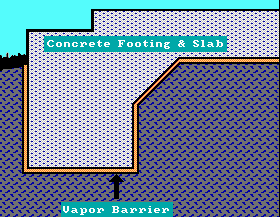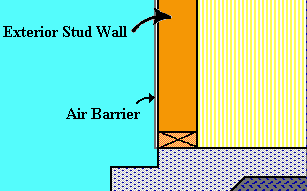AIR BARRIERS AND VAPOR BARRIERS

- GOAL:
- To become aware of energy efficient designs and construction that will save energy, cost less to operate and will have less of a negative impact on the natural environment.
- OBJECTIVES:
- The student will demonstrate knowledge and understanding of air barriers and vapor barriers and how they are used.
- LESSON/INFORMATION:
- There is considerable confusion on what the different barriers do, how they work, and how they should be placed in the building envelope. If placed incorrectly, these materials can cause severe problems for the home owner.
- Vapor barriers are used to control the flow of moisture through the building envelope. They should always be used under a concrete slab. This prevents ground moisture from being absorbed by the concrete. It also prevents the ground from absorbing moisture from the concrete when it is first poured, which allows the concrete to stay moist for a longer period of time. The slower the moisture evaporates from the concrete as it cures, the stronger the concrete.

- The placement of a vapor barrier in the wall has been a heavily debated subject for a long time. The vapor barrier is used to prevent moisture from moving through the wall. Moisture moves through the wall based on vapor pressure differences between one side of the wall and the other side.
- During the winter in south Louisiana the air is usually drier on the outside and more humid on the inside because of interior generated moisture from cooking, bathing and doing laundry. Because this situation is even worse in areas north of Louisiana with drier air and longer winters, the insulation companies suggest putting the vapor barrier on the warm side - which is the inside for this winter situation. The better solution for south Louisiana is to keep interior generated moisture to a minimum during the winter. This can be done by venting the areas of high moisture, like kitchens and bathrooms, to the exterior with an exhaust fan. Clothes driers should also be vented to the outside.
- During the summer, in south Louisiana, the outside air is laden with moisture while the air-conditioned space inside is much drier. This would suggest that the vapor barrier should be placed on the outside during the warmer time of the year. Never place a vapor barrier on both sides. This could trap moisture and cause decay. Current research suggests that if a vapor barrier is used, it should be placed on the inside of the wall for locations above Baton Rouge, and on the exterior for locations below Baton Rouge.
- The greater moisture problem during the summer is from infiltration. Air finds its way inside from openings around doors and windows, gaps in insulation, penetrations in the wall, at corners of the buildings, and under the sole plate of the wall. Condensation will occur, because of this infiltration, when the warm moist air hits cool metal vent pipes, electrical boxes in the wall, cool glass, cool concrete, or the cool foil face found on some types of insulation.
- To prevent this infiltration, air barriers work well. An air barrier prevents air movement while allowing moisture to pass through. The air barrier is wrapped over the exterior wall studs and should be carefully sealed where cut for penetrations such as plumbing and electrical access. This should be done in conjunction with good caulking practices and weatherstripping around doors and windows.

- ACTIVITY:
- A. Please indicate whether the following statements are TRUE or FALSE.
- 1. The incorrect placement of vapor barriers can cause severe problems for the home owner.
- 2. Vapor barriers control the flow of moisture through the building envelope.
- 3. Concrete slabs do not require a vapor barrier.
- 4. The faster the concrete dries, the stronger it is.
- 5. Moisture moves through a wall based on pressure differences between one side of the wall and the other side.
- 6 Areas of high moisture production, like the kitchen and bathroom, should be vented to the outside by exhaust fans.
- 7. It is best to place a vapor barrier on both sides of the wall.
- 8. The greatest moisture problem in Louisiana is from infiltration in the summer.
- 9. Air barriers are used to cut down on unwanted infiltration.
- 10. The air barrier is used to wrap the exterior sheathed envelope.
- B. List the various types and price per square foot of air and vapor barriers recommended for your area. Discuss this list with your instructor.
- TEACHER'S NOTES:
- A. Answers to True/False questions.
- 1. True
- 2. True
- 3. False
- 4. False
- 5. True
- 6. True
- 7. False
- 8. True
- 9. True
- 10. True
- RECOMMENDED READING:
- Building Control Systems. V. Bradshaw. New York: John Wiley & Sons, 1985.
- Natural Louisiana Architecture. Cazayoux, Hebert and Winn. Baton Rouge, LA: Louisiana Department of Natural Resources, 1991.
- REFERENCES:
- "The Comfort Zone" .....E.J. Cazayoux, USL Monthly Press Release
Comments or questions to: TechAsmt@LA.GOV
Return to Carpentry Menu



